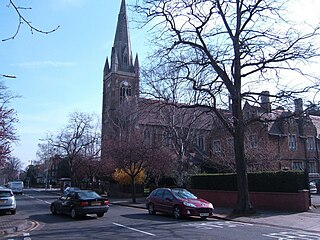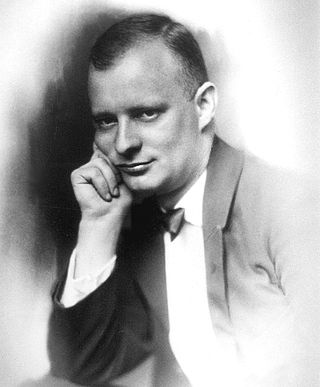
Edward Benjamin Britten, Baron Britten was an English composer, conductor, and pianist. He was a central figure of 20th-century British music, with a range of works including opera, other vocal music, orchestral and chamber pieces. His best-known works include the opera Peter Grimes (1945), the War Requiem (1962) and the orchestral showpiece The Young Person's Guide to the Orchestra (1945).

The War Requiem, Op. 66, is a large-scale setting of the Requiem composed by Benjamin Britten mostly in 1961 and completed in January 1962. The War Requiem was performed for the consecration of the new Coventry Cathedral, which was built after the original fourteenth-century structure was destroyed in a World War II bombing raid. The traditional Latin texts are interspersed, in telling juxtaposition, with extra-liturgical poems by Wilfred Owen, written during World War I.

Dame Edith Louisa Sitwell was a British poet and critic and the eldest of the three literary Sitwells. She reacted badly to her eccentric, unloving parents and lived much of her life with her governess. She never married but became passionately attached to Russian painter Pavel Tchelitchew, and her home was always open to London's poetic circle, to whom she was generous and helpful.
In music, variation is a formal technique where material is repeated in an altered form. The changes may involve melody, rhythm, harmony, counterpoint, timbre, orchestration or any combination of these.
Humphrey Searle was an English composer and writer on music. His music combines aspects of late Romanticism and modernist serialism, particularly reminiscent of his primary influences, Franz Liszt, Arnold Schoenberg and Anton Webern, who was briefly his teacher. As a writer on music, Searle published texts on numerous topics; he was an authority on the music of Franz Liszt, and created the initial cataloguing system for his works.
Ronald James Stevenson was a Scottish composer, pianist, and writer about music.

Kanon Pokajanen is a 1997 composition by Arvo Pärt for four-part (SATB) choir. The text is the "Canon of Repentance to Our Lord Jesus Christ", an Orthodox hymn. The text is sung in Church Slavonic and following the tradition of Russian sacred choral music, it is sung a cappella.

Façade is a series of poems by Edith Sitwell, best known as part of Façade – An Entertainment in which the poems are recited over an instrumental accompaniment by William Walton. The poems and the music exist in several versions.
Noel Mewton-Wood was an Australian-born concert pianist who achieved international fame on the basis of many distinguished concerto recordings during his short life.

Rejoice in the Lamb is a cantata for four soloists, SATB choir and organ composed by Benjamin Britten in 1943 and uses text from the poem Jubilate Agno by Christopher Smart (1722–1771). The poem, written while Smart was in an asylum, depicts idiosyncratic praise and worship of God by different things including animals, letters of the alphabet and musical instruments. Britten was introduced to the poem by W. H. Auden whilst visiting the United States, selecting 48 lines of the poem to set to music with the assistance of Edward Sackville-West. The cantata was commissioned by the Reverend Walter Hussey for the celebration of the 50th anniversary of the consecration of St Matthew's Church, Northampton. Critics praised the work for its uniqueness and creative handling of the text. Rejoice in the Lamb has been arranged for chorus, solos and orchestral accompaniment, and for SSAA choir and organ.
Still Falls the Rain may refer to:

Johannes Brahms composed his Piano Trio No. 2 in C Major, Op. 87, between 1880 and 1882. It is scored for piano, violin and cello. He wrote this piece at the age of 49.

The first Sonata for viola and piano, also known as Sonata in F, Op. 11, No. 4, by Paul Hindemith was composed in 1919. It is the fourth of five instrumental sonatas comprising his opus 11. This sonata and the following Op. 11 No. 5 for solo viola mark Hindemith's decision to abandon playing the violin in favor of its larger cousin.
Bernard Clements Barrell was an English musician, music educator and composer.
The five Canticles constitute a series of five musical works by composer Benjamin Britten. The pieces were written at various points in his career, with three of them written as memorials. Instrumentation differs on each piece, and several are based on non-sacred texts. A review in Opera Today notes, "Britten didn't draw upon the Scriptures for the texts of his canticles, which resemble cantatas more than church hymns in scale and structure, but an intense religious spirit pervades them all." Critic Peter Evans notes the works contain a "mood of spiritual elevation intense enough to demand realization in an ambitious musical structure."

The Magnificat by John Rutter is a musical setting of the biblical canticle Magnificat, completed in 1990. The extended composition in seven movements "for soprano or mezzo-soprano solo, mixed choir, and orchestra " is based on the Latin text, interspersed with "Of a Rose, a lovely Rose", an anonymous English poem on Marian themes, the beginning of the Sanctus and a prayer to Mary. The music includes elements of Latin American music.

Canticle IV: The Journey of the Magi, Op. 86, is a composition for three male solo voices and piano by Benjamin Britten, part of his series of five Canticles. It sets the text of T. S. Eliot's poem "Journey of the Magi", retelling the story of the biblical Magi. The work was premiered in June 1971 at the Aldeburgh Festival by James Bowman, Peter Pears and John Shirley-Quirk, with Britten as the pianist. It was published the following year, dedicated to the three singers.

Canticle II: Abraham and Isaac, Op. 51, is a composition for tenor, alto and piano by Benjamin Britten, part of his series of five Canticles. Commissioned to be performed as a fundraiser for the English Opera Group, it sets the story of Abraham and Isaac from the Chester Mystery Plays. Britten assigned the tenor voice of Peter Pears to Abraham, the alto of Kathleen Ferrier to Isaac, and both singers singing in homophony to the voice of God. The work was premiered on 20 January 1952 by Pears and Ferrier, with Britten as the pianist. It was published by Boosey & Hawkes in 1952, dedicated to the singers.










